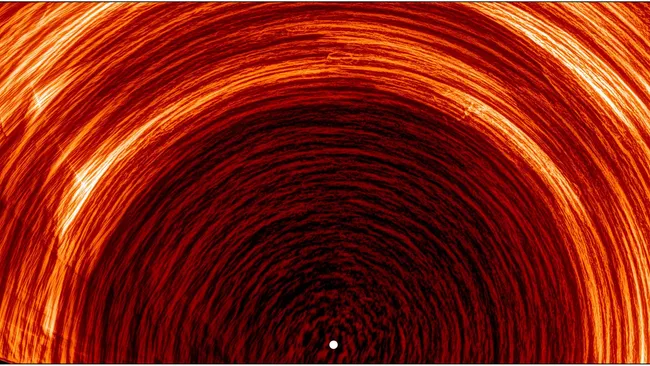In a groundbreaking discovery, the European Space Agency’s Solar Orbiter has delivered humanity’s first close-up look at the sun’s magnetic field near its southern pole — and the results have left scientists stunned.
Captured in March during the spacecraft’s first unobstructed view of the region, the image — a composite of eight days of observation — shows glowing arcs sweeping around the pole. These arcs are traces of magnetic structures drifting toward the sun’s edge at unexpectedly high speeds, suggesting the magnetic field is migrating toward the poles far faster than previously predicted.
“To understand the sun’s magnetic cycle, we still lack knowledge of what happens at the poles,” said Sami Solanki, director at the Max Planck Institute for Solar System Research in Germany and co-author of the study. “Solar Orbiter can now provide this missing piece of the puzzle.”
The sun’s magnetism operates on an 11-year cycle, during which its magnetic fields twist, flip, and rebuild — fueling sunspots, solar flares, and the massive storms that can strike Earth. At the core of this process lies a slow “magnetic conveyor belt” of plasma currents transporting magnetic field lines from the equator to the poles and back again. This circulation maintains the sun’s magnetism, but its polar dynamics have remained largely unknown — until now.
Observing the sun’s poles directly from Earth is nearly impossible; our planet’s vantage point only allows edge-on views. Most past spacecraft stayed close to the equatorial plane, leaving the poles uncharted. That changed in March 2025 when Solar Orbiter tilted its orbit by 17 degrees, granting researchers the first-ever direct look over the sun’s southern limb.
In their analysis, Solanki and his team used two of Solar Orbiter’s instruments: the Polarimetric and Helioseismic Imager (PHI) and the Extreme Ultraviolet Imager (EUI). These tools mapped how plasma and magnetic fields move across the solar surface, focusing on the chromosphere, where bright arcs trace the behavior of magnetic structures as the sun rotates.
The results were astonishing. Massive bubbles of plasma known as supergranules, each two to three times larger than Earth, were observed sweeping magnetic fields toward the poles at speeds between 20 and 45 miles per hour (32–72 kilometers per hour) — nearly matching equatorial flows and vastly exceeding earlier predictions.
“The supergranules at the poles act as tracers,” explained Lakshmi Pradeep Chitta, who led the research. “They make the polar component of the sun’s global, eleven-year circulation visible for the first time.”
The researchers describe the findings as the beginning of a “new era” in solar observation. For the first time, scientists can watch the magnetic engine that powers the sun — and by extension, influences the entire solar system — in real motion.
The study, published on November 5 in The Astrophysical Journal Letters, marks a milestone in our understanding of solar dynamics, bringing humanity one step closer to decoding the magnetic heartbeat of our star.

